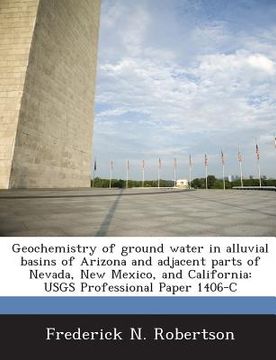Geochemistry of Ground Water in Alluvial Basins of Arizona and Adjacent Parts of Nevada, New Mexico, and California: Usgs Professional Paper 1406-C (en Inglés)
Reseña del libro "Geochemistry of Ground Water in Alluvial Basins of Arizona and Adjacent Parts of Nevada, New Mexico, and California: Usgs Professional Paper 1406-C (en Inglés)"
Chemical and isotope analyses of ground water from 28 basins in the Basin and Range physiographic province of Arizona and parts of adjacent States were used to evaluate ground-water quality, determine processes that control ground-water chemistry, provide independent insight into the hydrologic flow system, and develop information transfer. The area is characterized by north- to northwest-trending mountains separated by alluvial basins that form a regional topography of alternating mountains and valleys. On the basis of ground-water divides or zones of minimal basin interconnection, the area was divided into 72 basins, each representing an individual aquifer system. These systems are joined in a dendritic pattern and collectively constitute the major water resource in the region. Geochemical models were developed to identify reactions and mass transfer responsible for the chemical evolution of the ground water. On the basis of mineralogy and chemistry of the two major rock associations of the area, a felsic model and a mafic model were developed to illustrate geologic, climatic, and physiographic effects on ground-water chemistry. Two distinct hydrochemical processes were identified: (1) reactions of meteoric water with minerals and gases in recharge areas and (2) reactions of ground water as it moves down the hydraulic gradient. Reactions occurring in recharge and downgradient areas can be described by a 13-component system. Major reactions are the dissolution and precipitation of calcite and dolomite, the weathering of feldspars and ferromagnesian minerals, the formation of montmorillonite, iron oxyhydroxides, and probably silica, and, in some basins, ion exchange. The geochemical modeling demonstrated that relatively few phases are required to derive the ground-water chemistry; 14 phases-12 mineral and 2 gas-consistently account for the chemical evolution in each basin. The final phases were selected through analysis of X-ray diffraction and fluorescence data, aqueous speciation and saturation data, and mass-balance and isotopic constraints and through chemical models developed from mineral combinations among the 27 phases that were considered realistic in these geologically and mineralogically complex basins. X-ray diffraction of basin-fill sediments confirm the presence of the postulated minerals and their weathering sequences. High partial pressures of soil CO2 and large concentrations of dissolved CO2 in recharge areas, and the rapid depletion of CO2 downgradient, accompanied by high weathering rates of the silicates which also decrease downgradient, indicate that carbonic acid is the impetus in the weathering process. Reactions in the soil zone and the unsaturated zone are influential and, in some instances, are as important as the mineralogy of the source rock in determining ground-water compositions. The basins can be divided geochemically into two general categories-closed systems, which evolve under closed hydrologic conditions, and open systems, which are open to CO2 and other constituents along the flow path. The ground-water chemistry of the unconfined aquifers in the eastern part of the study area and of the aquifers underlying the flood plain along the Colorado River generally evolves under open conditions. The ground-water chemistry of most basins in the central and western parts and of the confined aquifers in the eastern part evolves under closed conditions. The factors that determine whether a basin is an open or closed system are the amount of and the spatial and seasonal distribution of annual precipitation and the presence or absence of fine-grained confining units. The basins along the Colorado River are unique among basins in the region. Virtually all ground water underlying the flood plain originated as seepage or overbank flow from the Colorado River.

